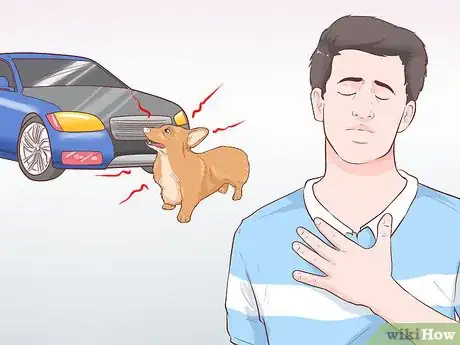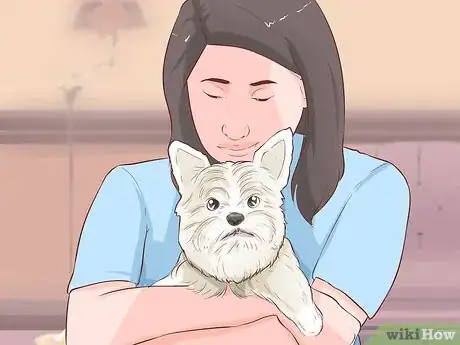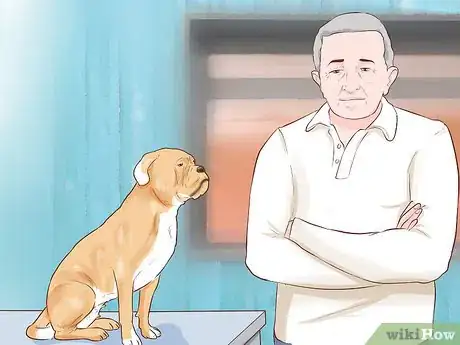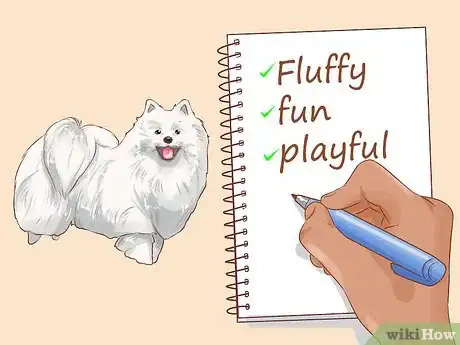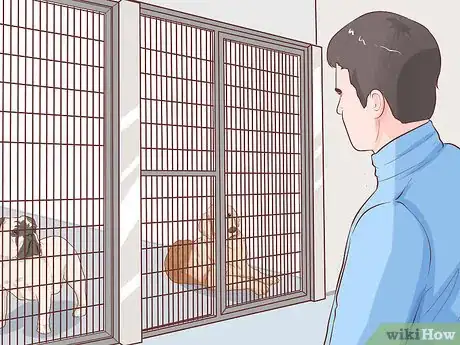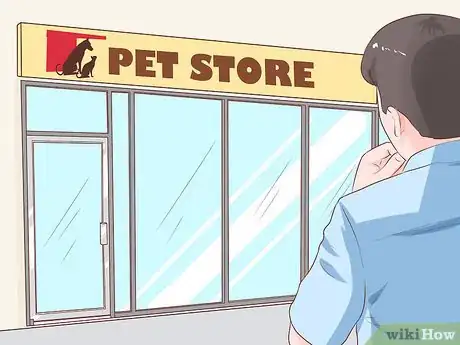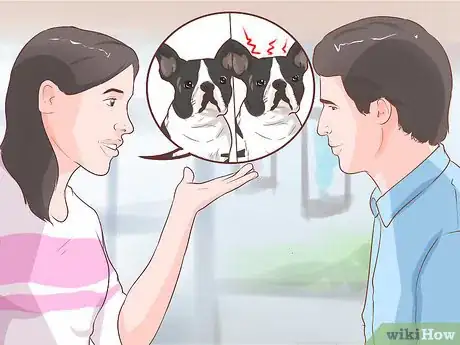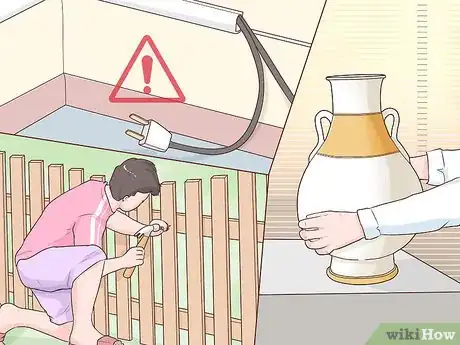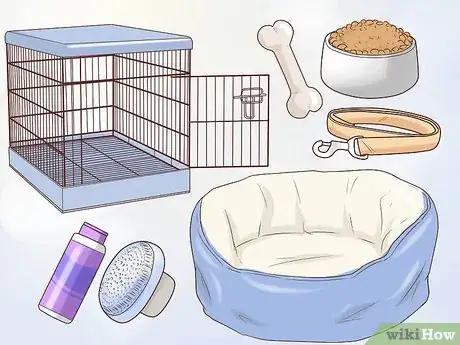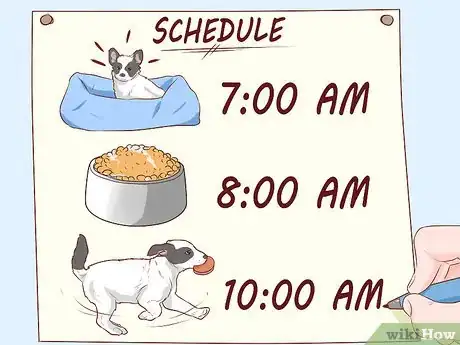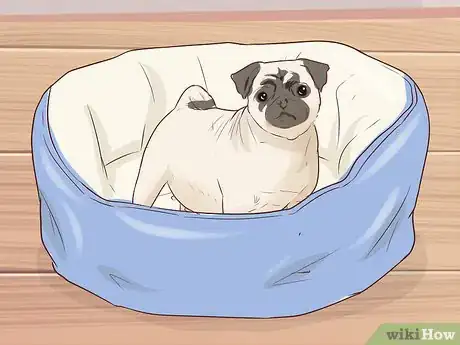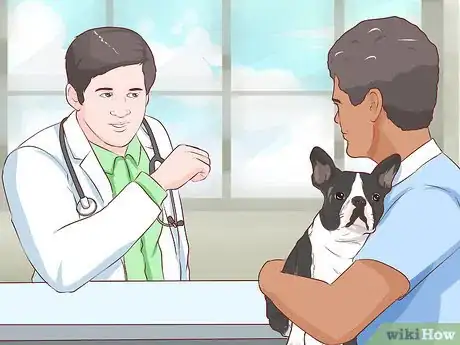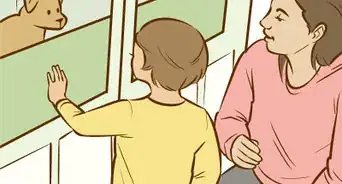This article was co-authored by Adam Dorsay, PsyD. Dr. Adam Dorsay is a licensed psychologist in private practice in San Jose, CA, and the co-creator of Project Reciprocity, an international program at Facebook's Headquarters, and a consultant with Digital Ocean’s Safety Team. He specializes in assisting high-achieving adults with relationship issues, stress reduction, anxiety, and attaining more happiness in their lives. In 2016 he gave a well-watched TEDx talk about men and emotions. Dr. Dorsay has a M.A. in Counseling from Santa Clara University and received his doctorate in Clinical Psychology in 2008.
There are 10 references cited in this article, which can be found at the bottom of the page.
This article has been viewed 72,918 times.
Moving on after the death of a dog is difficult. You undoubtedly miss having your pet around, but how do you know when you’re ready to get a new dog? Every person deals with the death of a pet differently, so there’s no definitive answer to this question. However, allowing yourself to grieve your loss and closely assessing your feelings can help you figure out when the time is right. Being prepared, both mentally and physically, to welcome a new dog into your home will make the transition easier on both you and your new pet.
Things You Should Know
- There's no set timeline on how long to wait to get another dog after losing one. Take some time to grieve and get another dog whenever you feel ready.
- Choose a breed with characteristics that align with your lifestyle. Then pick a dog from a shelter or breeder with a personality or temperament you enjoy.
- Welcome your new dog into your home and make sure you have all the supplies you need to care for your new furry friend.
Steps
Deciding When You’re Ready for a New Dog
-
1Allow yourself time to grieve. There is no set amount of time you must allow to get over the loss of a pet. The amount of time needed to grieve is different for every person and situation. You must, however, let yourself go through the grieving process before getting another pet. Rushing into adopting another dog won’t be fair to you or your new dog.[1]
- It can be tempting to rush to get another dog shortly after your dog dies. Some people think this will fill the void left in their life or take their mind off losing their pet. If you’re not ready for a new dog it can be tough on both you and the dog. [2]
- It can help to approach your grief with gratitude. Think about what your dog did for you, and how your life is better off for having known them. It can also help to write a eulogy for your pet.
-
2Pay close attention to your feelings. Losing a dog, whether unexpectedly or not, can cause an array of emotions, including grief, guilt, confusion, anger, and depression. The type of reactions you experience can depend on a number of things, including your upbringing, personality, and the way the dog died. The emotions you feel and the intensity at which you feel them is different for every person and in every situation. After the loss of a dog, pay close attention to how you are feeling about its death. Your ability to deal with these emotions and work through them will have a profound impact on your readiness to get another dog.[3]
- For example, say you left your apartment door open slightly and your dog ran out into the street and got hit by a car. You may have intense feelings of guilt over this, feeling that you were part of the reason your pet died. Until you can forgive yourself and work through this guilt, you probably won’t be able to care for a new dog properly.
- However, if your dog died of natural causes at 16 years old, you likely won’t feel guilt over its death. While you will still need to work through your grief over your loss, you may be able to accept your pet’s death much more quickly, and therefore be able to properly care for a new dog much sooner.
Advertisement -
3Ask yourself if you’re ready for another dog. The grieving process is different for every individual. For some people, it might only take months to grieve the loss of a dog, but for others, this process could take years. When you’re considering getting a new dog after a pet’s death, ask yourself if you’re ready to make a commitment to another dog. The following questions can help you in your decision:
- Do I have time for a new dog? Can I devote time to training and socializing it?
- Am I happy without a dog? Are there things I’ve been putting off while caring for my old dog?[4]
- Ask yourself why you want another dog—what purpose will a new dog have in your life? If you’re getting a new dog just to fill the void of losing your old one, or to ease the pain, you should wait.[5]
Choosing a Breed
-
1Understand your new dog is not a replacement. One of the toughest things for people to understand after losing a dog is that a new dog is not, and should not be looked at, as a replacement for your old dog. Nothing will every replace your old dog. Your new dog will have a different personality and quirks, and you will need to build a whole new relationship with it.
- It can help to get a different breed or a different sex when selecting a new dog. This can help you not to make comparisons between your old dog and new dog.[6]
-
2Think about your current living situation. Depending on how long you had your previous dog, your living situation might have changed significantly since you first got it. When deciding what type of dog to get, consider your new situation. This can affect such things as whether you want a big dog or little one, a puppy or a mature dog, or a long-haired or short-haired one. Ask yourself some of the following questions to help you decide which type of dog will best suit your new needs and lifestyle:
- Are you living in an apartment or a home with a backyard?
- If you work full-time, is there anyone who can help you with training your new dog?
- What type of climate do you live in?
- How much time and energy are you willing and able to put into taking care of a new dog?[7]
-
3Evaluate your physical capabilities. Your health may have changed since you adopted your last dog as well. You must also take this into consideration when you’re trying to figure out what kind of dog to get. Larger breeds will need more physical activity than smaller breeds. Different breeds have different energy levels as well. Choose a dog that will be compatible with your current abilities.[8]
-
4Make a list of qualities you want in a dog. Taking into consideration your current situation, list all the qualities you want in your new dog, starting with the most important at the top. This will make it easier to focus on the qualities that are most important when you’re picking out your new dog.[9]
Picking Out a New Dog
-
1Look at shelters. Animal shelters often have tons of great dogs available for adoption. As long as you know what you’re looking for in your new pet, you will probably be able to find a suitable dog at a shelter near you. Shelters also have many different breeds of dog available, so if you aren’t set on a particular breed, this can be a good way to get acquainted with several different ones before deciding.[10]
- The staff at animal shelters are often familiar with many different breeds of dog so they can probably help you decide which might be the best fit for you.[11]
- Don’t get discouraged if you don’t find your new companion right away. You may have to look at a lot of shelters, and a lot of dogs, before you find the one that is the right fit for you.
- There are also rescues for just about every breed of dog. If you have a specific breed in mind, this may be a good option since all of their dogs will be the type of breed you’re looking for.[12]
-
2Contact breeders. If you know what breed of dog you want, contacting local breeders may be a good option as well. As long as the breeder is responsible, you can likely find a puppy that is healthy and well cared for from a breeder.
- Keep in mind that this will probably be a much more expensive option than adopting from a shelter or rescue.[13] On average, puppies obtained from a breeder cost anywhere from several hundred dollars up to several thousand.
- In addition, most breeders only sell puppies. If you’re looking for an older dog, a breeder probably won’t be the right option for you.
- Always ask to take a look around your breeder’s premises before buying from them. You want to make sure your puppy was treated well and raised under good conditions before deciding to buy.[14]
-
3Visit pet stores. Pet stores may also have a variety of dogs to choose from. While many will be puppies, they may have some older dogs as well.
- Pet stores, however, are becoming a less popular place to get a dog, with many people preferring to adopt from shelters or buy from a breeder. Many people believe most pet stores get their puppies from puppy mills where there is abuse and ill-treatment of dogs. Puppy mill dogs can also suffer from a number of health problems.[15]
- Do your research and trust your gut. If you get a bad feeling from a pet store, it is best to keep looking.
-
4Ask about the dog’s personality/temperament. No matter where you get your dog, the staff or breeder should be able to give you some insight into its personality and temperament. Ask them things like how it gets along with the other dogs, with new people, and with children.
- For example, if your new dog will be around new people often, a shy dog may not be the right choice for you. A dog that is outgoing and friendly towards new people might be a better choice.
Bringing Your New Dog Home
-
1Prepare your home. Whether it has been only a few months since you’ve had a dog or a few years, there are things you need to take care of around your house before brining your new dog home. Dog-proofing your house before your new pup comes home will ensure your new dog, and your belongings, are kept safe.
- Ensure electrical cords are inaccessible.
- Block off any areas of the house you do not want your dog to go into. If you can’t do this by shutting a door, you can often use baby gates to keep dogs out of certain areas.
- Move breakable objects out of your dog’s reach.
- Keep shoes and other “chewables” tucked away in closets or up on shelves and away from your dog.
- Remove or cut off access to any houseplants that may be toxic to your new dog.
- If you have a yard, ensure fences are secure and there are no holes through which your new dog can escape.[16]
-
2Get essential items. Be sure you have any food, treats, toys, and grooming tools you need before you bring your new dog home. Also, have a collar ready when it gets home. Getting the essentials ahead of time ensures your dog’s transition to its new home will be as smooth as possible for everyone involved.[17]
- You may still have some of these items around from when your old dog was alive. Feel free to re-use whatever you have, but make sure these items are appropriate for your new dog, especially if you got a different breed. Each breed often has specific nutritional and grooming requirements so check with your shelter staff, breeder, or veterinarian to make sure you have the right items.
-
3Create a schedule. If this is a family dog, it’s important to figure out who will take care of which responsibilities before brining your new pet home. Create a schedule that shows the tasks each person is responsible for and make sure this schedule is displayed somewhere everyone in the family will see it on a daily basis.[18]
-
4Make a “home” for your dog. Just like people, dogs need a place they can have to themselves. This can be anything from a crate or a dog bed to a mat with a pile of blankets, as long as it is a comfortable place your dog can go for privacy and to relax. While this spot doesn’t need to be shut off from the rest of the house, family members need to understand that the dog should be left alone when it’s in this place.[19]
-
5Find a veterinarian. Whether you are using the same vet you had for your old dog or are looking for a new vet, take your new dog for a check-up shortly after brining it home. This will allow you to establish a relationship with your vet and make sure your new dog doesn’t have any health problems the shelter, breeder, or pet store missed.
- Don’t wait until there is an emergency to find a vet. Finding a vet both you and your dog like early on will help cut down on stress in the event of an emergency and encourage you to take your dog for regular visits, allowing you to catch any health problems early on.[20]
Community Q&A
-
QuestionMy dog died last year, but my mum doesn't want another one because she said I wouldn't help with the cost and that I would just get bored with it. How do I convince her?
 Community AnswerStart saving up your money so that you can really help pay for it. Do everything you can to show her that you're responsible, like keeping up with your schoolwork and doing your chores without being asked. Don't bring up the dog constantly or she'll get annoyed and say no.
Community AnswerStart saving up your money so that you can really help pay for it. Do everything you can to show her that you're responsible, like keeping up with your schoolwork and doing your chores without being asked. Don't bring up the dog constantly or she'll get annoyed and say no. -
QuestionMy dog is going to die soon and I want to bring another dog home, but my parents won't allow me to. What should I do? I love my dog and will miss my dog!
 Community AnswerConvince your parents to let you bring the dog home. If there are reasons why your dog is dying talk about the reasons and say that you could do better next time. If your dog is dying of something that couldn't be prevented, explain how well you took care of your dog this time and that you would do the same for the other one, plus you'll miss your dog so much you'll need a new companion.
Community AnswerConvince your parents to let you bring the dog home. If there are reasons why your dog is dying talk about the reasons and say that you could do better next time. If your dog is dying of something that couldn't be prevented, explain how well you took care of your dog this time and that you would do the same for the other one, plus you'll miss your dog so much you'll need a new companion. -
QuestionMy puppy died a few months ago from a really traumatic dog bite. We now have an opportunity to get a new dog, we went to look at it the other day. I am conflicted about whether we should get a new puppy or not.
 Community AnswerOnly you can know when the appropriate time of mourning for your lost puppy has passed. Nevertheless, the joyful enthusiasm and liveliness of a new puppy could go a long way towards easing the pain of losing a pet. Hopefully you will be able to avoid fatal or traumatic attacks on your dogs in the future.
Community AnswerOnly you can know when the appropriate time of mourning for your lost puppy has passed. Nevertheless, the joyful enthusiasm and liveliness of a new puppy could go a long way towards easing the pain of losing a pet. Hopefully you will be able to avoid fatal or traumatic attacks on your dogs in the future.
Warnings
- When dealing with the death of a family dog, ensure all the members of the family are ready to get a new dog. It might take some members longer to get through the grieving process than others.⧼thumbs_response⧽
References
- ↑ http://www.humanesociety.org/animals/resources/tips/coping_with_pet_death.html#another
- ↑ https://www.helpguide.org/articles/grief-loss/coping-with-pet-loss.htm#getting
- ↑ https://www.helpguide.org/articles/grief/coping-with-losing-a-pet.htm
- ↑ http://www.vetstreet.com/our-pet-experts/after-a-loss-the-right-time-for-a-new-dog?page=2
- ↑ https://pethelpful.com/dogs/How-long-should-I-wait-after-my-dies-to-get-another-one
- ↑ http://www.vetstreet.com/our-pet-experts/after-a-loss-the-right-time-for-a-new-dog?page=2
- ↑ http://www.petmd.com/dog/care/evr_dg_before_getting_a_dog
- ↑ http://www.akc.org/dog-owners/responsible-dog-ownership/#thinkfirst
- ↑ http://www.akc.org/dog-owners/responsible-dog-ownership/#thinkfirst
- ↑ http://lifehacker.com/where-to-start-when-youve-decided-you-want-a-dog-1665643067
- ↑ http://lifehacker.com/where-to-start-when-youve-decided-you-want-a-dog-1665643067
- ↑ http://www.humanesociety.org/issues/puppy_mills/tips/buying_puppy.html?credit=fb_post2015
- ↑ https://www.aspca.org/news/10-reasons-adopt-shelter-dog
- ↑ http://www.humanesociety.org/issues/puppy_mills/tips/buying_puppy.html?credit=fb_post2015
- ↑ http://www.humanesociety.org/issues/puppy_mills/tips/buying_puppy.html?credit=fb_post2015
- ↑ http://www.akc.org/dog-owners/responsible-dog-ownership/#thinkfirst
- ↑ http://www.akc.org/dog-owners/responsible-dog-ownership/#thinkfirst
- ↑ http://www.akc.org/dog-owners/responsible-dog-ownership/#thinkfirst
- ↑ http://www.akc.org/dog-owners/responsible-dog-ownership/#thinkfirst
- ↑ http://www.akc.org/dog-owners/responsible-dog-ownership/#thinkfirst
About This Article
Getting another dog after yours has died can be an emotional time, but you'll know when the time is right. For instance, if you feel guilty about the circumstances of your dog’s death or if you want a new one to ease the pain, it's okay to wait a little while before getting a new dog. Grief affects everyone differently, so give yourself as much time as you need to process your loss. If you're having doubts about getting a new dog, try giving yourself a little more time and re-evaluating your feelings. You can also consider getting a different breed or sex to your old dog if you think it will help. For more tips, like how to welcome your new dog into your home, read on!

